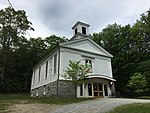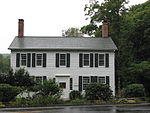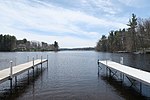Montville Baptist Church
Baptist churches in MassachusettsChurches in Berkshire County, MassachusettsChurches on the National Register of Historic Places in MassachusettsFormer synagogues in MassachusettsNational Register of Historic Places in Berkshire County, Massachusetts ... and 1 more
Sandisfield, Massachusetts

The Montville Baptist Church, now known as the Sandisfield Arts Center, is an historic former Baptist church and Orthodox Jewish synagogue at 5 Hammertown Road in Sandisfield, Massachusetts. The Greek Revival building was constructed in 1839 as a Baptist church. After 83 years as a Baptist church meeting house, the building was converted into use as an Orthodox synagogue for 75 years. In 1995 the Sandisfield Arts Center formed as a non-profit to preserve the building. The building was added to the National Register of Historic Places in 2006.
Excerpt from the Wikipedia article Montville Baptist Church (License: CC BY-SA 3.0, Authors, Images).Montville Baptist Church
Hammertown Road,
Geographical coordinates (GPS) Address Nearby Places Show on map
Geographical coordinates (GPS)
| Latitude | Longitude |
|---|---|
| N 42.118611111111 ° | E -73.124722222222 ° |
Address
Hammertown Road 5
01255
Massachusetts, United States
Open on Google Maps








